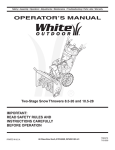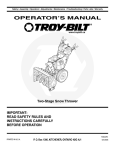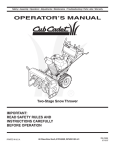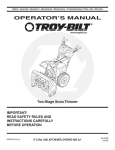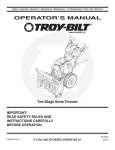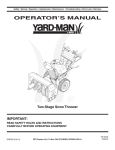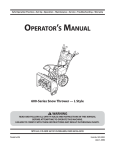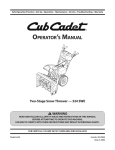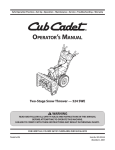Download White Outdoor 10.5-30SW Operator`s manual
Transcript
Safety • Assembly • Operation • Adjustments • Maintenance • Troubleshooting • Parts Lists • Warranty OPERATOR’S MANUAL 10.5-30SW Two-Stage Snow Thrower IMPORTANT: READ SAFETY RULES AND INSTRUCTIONS CAREFULLY BEFORE OPERATION 772C0784 PRINTED IN U.S.A. 60 Ottawa Street South, KITCHENER, ONTARIO N2G 3S7 7/12/2005 This Operator’s Manual is an important part of your new snow thrower. It will help you assemble, prepare and maintain the unit for best performance. Please read and understand what it says. Table of Contents Safety Labels ...................................................... 3 Safe Operation Practices ................................... 4 Setting Up Your Snow Thrower .......................... 6 Operating Your Snow Thrower ......................... 10 MakingAdjustments ......................................... 14 Maintaining Your Snow Thrower ...................... 16 Off-Season Storage .......................................... 20 Trouble Shooting .............................................. 21 Warranty ............................................................ 22 Illustrated Parts Lists ....................................... 23 Finding and Recording Model Number BEFORE YOU START ASSEMBLING YOUR NEW EQUIPMENT, please locate the model plate on the equipment and copy the the model number and the serial number to the sample model plate provided to the right. You can locate the model plate by standing at the operating position and looking down at the frame. ������������ ���������������� ���������� ������������� ��������������� ����������� �������������������� ��������������������� Customer Support 1. If you have difficulty assembling this product or have any questions regarding the controls, operation or maintenance of this unit, please call an authorized dealer. Please have your unit’s model number and serial number ready when you call. See previous section to locate this information. 2. The engine manufacturer is responsible for all enigne-related issues with regards to performance, power-rating, specifications, warranty and service. Please refer to the engine manufacturer’s Owner’s/Operator’s Manual, packed separately with your unit, for more information. 2 1 Safety Labels WARNING ������� Chute Clean-out Tool A chute clean-out tool is fastened to the top of the auger housing with a mounting clip. The tool is designed to clear a chute assembly of ice and snow. This item is fastened with a cable tie at the factory. Cut the cable tie before operating the snow thrower. WARNING: Never use your hands to clear a clogged chute assembly. Shut off engine and remain behind handles until all moving parts have stopped before using the clean-out tool to clear the chute assembly. 3 This symbol points out important safety instructions which, if not followed, could endanger the personal safety and/or property of yourself and others. Read and follow all instructions in this manual before attempting to operate this machine. Failure to comply with these instructions may result in personal injury. When you see this symbol. HEED ITS WARNING! Your Responsibility Restrict the use of this power machine to persons who read, understand and follow the warnings and instructions in this manual and on the machine. 2 Safe Operation Practices WARNING This symbol points out important safety instructions which, if not followed, could endanger the personal safety and/or property of yourself and others. Read and follow all instructions in this manual before attempting to operate this machine. Failure to comply with these instructions may result in personal injury. When you see this symbol. WARNING: Engine Exhaust, some of its constituents, and certain vehicle components contain or emit chemicals known to State of California to cause cancer and birth defects or other reproductive harm. DANGER: This machine was built to be operated according to the rules for safe operation in this manual. As with any type of power equipment, carelessness or error on the part of the operator can result in serious injury. This machine is capable of amputating hands and feet and throwing objects. Failure to observe the following safety instructions could result in serious injury or death. Training Preparation 1. Read, understand, and follow all instructions on the machine and in the manual(s) before attempting to assemble and operate. Keep this manual in a safe place for future and regular reference and for ordering replacement parts. 2. Be familiar with all controls and their proper operation. Know how to stop the machine and disengage them quickly. 3. Never allow children under 14 years old to operate this machine. Children 14 years old and over should read and understand the operation instructions and safety rules in this manual and should be trained and supervised by a parent. 4. Never allow adults to operate this machine without proper instruction. 5. Thrown objects can cause serious personal injury. Plan your snow-throwing pattern to avoid discharge of material toward roads, bystanders and the like. 6. Keep bystanders, helpers, pets and children at least 75 feet from the machine while it is in operation. Stop machine if anyone enters the area. 7. Exercise caution to avoid slipping or falling, especially when operating in reverse. 1. Thoroughly inspect the area where the equipment is to be used. Remove all doormats, newspapers, sleds, boards, wires and other foreign objects, which could be tripped over or thrown by the auger/impeller. 2. Always wear safety glasses or eye shields during operation and while performing an adjustment or repair to protect your eyes. Thrown objects which ricochet can cause serious injury to the eyes. 3. Do not operate without wearing adequate winter outer garments. Do not wear jewelry, long scarves or other loose clothing, which could become entangled in moving parts. Wear footwear which will improve footing on slippery surfaces. 4. Use a grounded three-wire extension cord and receptacle for all units with electric start engines. 5. Adjust collector housing height to clear gravel or crushed rock surfaces. 6. Disengage all control levers before starting the engine. 7. Never attempt to make any adjustments while engine is running, except where specifically recommended in the operator’s manual. 8. Let engine and machine adjust to outdoor temperature before starting to clear snow. 9. To avoid personal injury or property damage use extreme care in handling gasoline. Gasoline is extremely flammable and the vapors are explosive. Serious personal injury can occur when gasoline is spilled on yourself or your clothes, which can ignite. Wash your skin and change clothes immediately. a. Use only an approved gasoline container. b. Extinguish all cigarettes, cigars, pipes and other sources of ignition. c. Never fuel machine indoors. d. Never remove gas cap or add fuel while the engine is hot or running. e. Allow engine to cool at least two minutes before refueling. f. Never over fill fuel tank. Fill tank to no more than ½ inch below bottom of filler neck to provide space for fuel expansion. g. Replace gasoline cap and tighten securely. h. If gasoline is spilled, wipe it off the engine and equipment. Move machine to another area. Wait 5 minutes before starting the engine. i. Never store the machine or fuel container inside where there is an open flame, spark or pilot light (e.g. furnace, water heater, space heater, clothes dryer etc.). j. Allow machine to cool at least 5 minutes before storing. HEED ITS WARNING! Your Responsibility Restrict the use of this power machine to persons who read, understand and follow the warnings and instructions in this manual and on the machine. 4 Operation Maintenance & Storage 1. Do not put hands or feet near rotating parts, in the auger/impeller housing or chute assembly. Contact with the rotating parts can amputate hands and feet. 2. The auger/impeller control lever is a safety device. Never bypass its operation. Doing so makes the machine unsafe and may cause personal injury. 3. The control levers must operate easily in both directions and automatically return to the disengaged position when released. 4. Never operate with a missing or damaged chute assembly. Keep all safety devices in place and working. 5. Never run an engine indoors or in a poorly ventilated area. Engine exhaust contains carbon monoxide, an odorless and deadly gas. 6. Do not operate machine while under the influence of alcohol or drugs. 7. Muffler and engine become hot and can cause a burn. Do not touch. 8. Exercise extreme caution when operating on or crossing gravel surfaces. Stay alert for hidden hazards or traffic. 9. Exercise caution when changing direction and while operating on slopes. 10. Plan your snow-throwing pattern to avoid discharge towards windows, walls, cars etc. Thus, avoiding possible property damage or personal injury caused by a ricochet. 11. Never direct discharge at children, bystanders and pets or allow anyone in front of the machine. 12. Do not overload machine capacity by attempting to clear snow at too fast of a rate. 13. Never operate this machine without good visibility or light. Always be sure of your footing and keep a firm hold on the handles. Walk, never run. 14. Disengage power to the auger/impeller when transporting or not in use. 15. Never operate machine at high transport speeds on slippery surfaces. Look down and behind and use care when backing up. 16. If the machine should start to vibrate abnormally, stop the engine, disconnect the spark plug wire and ground it against the engine. Inspect thoroughly for damage. Repair any damage before starting and operating. 17. Disengage all control levers and stop engine before you leave the operating position (behind the handles). Wait until the auger/impeller comes to a complete stop before unclogging the chute assembly, making any adjustments, or inspections. 18. Never put your hand in the discharge or collector openings. Always use the clean-out tool provided to unclog the discharge opening. Do not unclog chute assembly while engine is running. Shut off engine and remain behind handles until all moving parts have stopped before unclogging. 19. Use only attachments and accessories approved by the manufacturer (e.g. wheel weights, tire chains, cabs etc.). 20. If situations occur which are not covered in this manual, use care and good judgment. Call customer assistance for the name of your nearest servicing dealer. 1. Never tamper with safety devices. Check their proper operation regularly. 2. Disengage all control levers and stop the engine. Wait until the auger/impeller come to a complete stop. Disconnect the spark plug wire and ground against the engine to prevent unintended starting before cleaning, repairing, or inspecting. 3. Check bolts and screws for proper tightness at frequent intervals to keep the machine in safe working condition. Also, visually inspect machine for any damage. 4. Do not change the engine governor setting or over-speed the engine. The governor controls the maximum safe operating speed of the engine. 5. Snow thrower shave plates and skid shoes are subject to wear and damage. For your safety protection, frequently check all components and replace with original equipment manufacturer’s (OEM) parts only. “Use of parts which do not meet the original equipment specifications may lead to improper performance and compromise safety!” 6. Check controls periodically to verify they engage and disengage properly and adjust, if necessary. Refer to the adjustment section in this operator’s manual for instructions. 7. Maintain or replace safety and instruction labels, as necessary. 8. Observe proper disposal laws and regulations for gas, oil, etc. to protect the environment. 9. Prior to storing, run machine a few minutes to clear snow from machine and prevent freeze up of auger/impeller. 10. Never store the machine or fuel container inside where there is an open flame, spark or pilot light such as a water heater, furnace, clothes dryer etc. 11. Always refer to the operator’s manual for proper instructions on off-season storage. Do not modify engine To avoid serious injury or death, do not modify engine in any way. Tampering with the governor setting can lead to a runaway engine and cause it to operate at unsafe speeds. Never tamper with factory setting of engine governor. Notice regarding Emissions Engines which are certified to comply with California and federal EPA emission regulations for SORE (Small Off Road Equipment) are certified to operate on regular unleaded gasoline, and may include the following emission control systems: Engine Modification (EM) and Three Way Catalyst (TWC) if so equipped. 2 Safe Operation Practices WARNING This symbol points out important safety instructions, which if not followed, could endanger the personal safety and/or property of yourself and others. Read and follow all instructions in this manual before attempting to operate this machine. Failure to comply with these instructions may result in personal injury. When you see this symbol. HEED IT’S WARNING! Your Responsibility Restrict the use of this power machine to persons who read, understand and follow the warnings and instructions in this manual and on the machine. 5 3 Setting Up Your Snow Thrower IMPORTANT: The snow thrower is shipped with oil and WITHOUT GASOLINE. After assembly, refer to separate engine manual for proper fuel and engine oil recommendations. 1. Observe the lower area of the snow thrower to be sure both cables are aligned with roller guides before pivoting handle upward. 1 � a. Pull up and back on upper handle as shown in Figure 1. Align upper handle with the lower handle. � b. Tighten hand knobs securing upper handle to lower handle. 2. Remove wing nut and hex screw from chute control assembly and clevis pin and cotter pin from chute support bracket. See Figure 2. Position the chute assembly (forward-facing) over the chute base. NOTE: References to right or left side of the snow thrower are determined from behind the unit in the operating position. NOTE: This Operator’s Manual covers several models, handle panels, lights and chute cranks are some features that may vary by model. Not all features referenced in this manual are applicable to all snow thrower models. 3. Place chute assembly onto chute base and secure chute control assembly to chute support bracket with clevis pin and cotter pin removed earlier. See Figure 3. Figure 1 2 Figure 2 3 NOTE: Two replacement auger shear pins are included with this manual (or stowed in the plastic handle panel). Refer to Augers in the Maintainance Section for more information regarding shear pin replacement. Figure 3 6 4. Finish securing chute control assembly to chute support bracket with wing nut and hex screw removed earlier. See Figure 4. 3 4 Setting Up Your Snow Thrower CAUTION Figure 4 5 5. Check that all cables are properly routed through the cable guide on top of the engine. See Figure 5. The extension cord is fastened with a cable tie to the rear of the auger housing for shipping purposes. Cut the cable tie and remove it before operating the snow thrower. CAUTION: Prior to operating your snow thrower, refer to Auger Control Test on page 13. Read and follow all instructions carefully, and perform all adjustments to verify your snow thrower is operating safely and properly. Figure 5 Shear Pin Storage An area for convenient shear pin storage is located under the plastic dash panel. See Figure 6. Figure 6 7 Prior to operating your snow thrower, refer to Auger Control Test on page 13. Read and follow all instructions carefully and perform all adjustments to verify your unit is operating safely and properly. 3 Drift Cutters (If Equipped) Drift cutters should be used when operating the snow thrower in heavy drift conditions. • On models so equipped, drift cutters are assembled to the auger housing inverted. See Figure 7. • Remove the carriage bolts by unthreading the hex nuts which secure them, and reinstall the drift cutters facing forward before operating the snow thrower. Refer to Figure 8. Setting Up Your Snow Thrower If your unit is not equipped with drift cutters, you may contact Customer Support as instructed on page 2 for information regarding price and availability. Snow Thrower Model Drift Cutter Kit: All modelsOEM-390-679 Figure 7 WARNING Never use your hands to clean snow and ice from the chute assembly or auger housing. IMPORTANT Under any circumstance do not exceed manufacturer’s recommended psi. Equal tire pressure should be maintained at all times. Excessive pressure when seating beads may cause tire/rim assembly to burst with force sufficient to cause serious injury. Refer to sidewall of tire for recommended pressure. Figure 8 Figure 9 8 Clean-Out Tool Clean-Out Tool The clean-out tool is mounted to the rear of the auger housing and is designed to clear a clogged chute. Refer to page 11 for instructions on how to properly use it. NOTE: This item is fastened with a cable tie to the rear of the auger housing at the factory. Cut the cable tie before operating the snow thrower. WARNING: Never use your hands to clean snow and ice from the chute assembly or auger housing. 3 Setting Up Your Snow Thrower Skid Shoes Figure 10 Position the skid shoes based on surface conditions. Adjust upward for hard-packed snow. Adjust downward when operating on gravel or crushed rock surfaces. Tire Pressure (Pneumatic Tires) The tires are over-inflated for shipping purposes. Check the tire pressure before operating the snow thrower. Refer to the tire side wall for tire manufacturer’s recommended psi and deflate (or inflate) the tires as necessary. NOTE: If the tire pressure is not equal in both tires, the unit may not travel in a straight path and the shave plate may wear unevenly. WARNING Never use your hands to clean snow and ice from the chute assembly or auger housing. General Recommendations 1. Always observe safety rules when performing any maintenance. 2. The warranty on this snow thrower does not cover items that have been subjected to operator abuse or negligence. To receive full value from warranty, operator must maintain the snow thrower as instructed here. 3. Some adjustments will have to be made periodically to maintain your unit properly. 4. Periodically check all fasteners and make sure these are tight. 9 IMPORTANT Under any circumstance do not exceed manufacturer’s recommended psi. Equal tire pressure should be maintained at all times. Excessive pressure when seating beads may cause tire/rim assembly to burst with force sufficient to cause serious injury. Refer to sidewall of tire for recommended pressure. 4 Operating Your Snow Thrower Know Your Snow Thrower ������������� ����������� �������� �������������� ������������� �������������� ������������������� ��������� �������������� ������� ��������������������� ������� �������� ��������������� ��������������� ������ ����������������������� ������ ��������� ��� WARNING Read, understand, and follow all instructions and warnings on the machine and in this manual before operating. ������ ������� ��������� ���� ������������� ��������� ��������� ������� Figure 11 Use extreme care when handling gasoline. Gasoline is extremely flammable and the vapors are explosive. Never fuel the machine indoors or while the engine is hot or running. Extinguish cigarettes, cigars, pipes and other sources of ignition. Now that you have set up your snow thrower for operation, get acquainted with its controls and features. These are described below and illustrated in Figure 11. This knowledge will allow you to use your new equipment to its fullest potential. NOTE: For detailed starting instructions and more information on all engine controls, refer to the separate engine manual packed with your unit. Shift Lever The shift lever is located on the right side of the handle panel. Place the shift lever into any of eight positions to control the direction of travel and ground speed. Forward Your snow thrower has six forward (F) speeds, with position number one (1) being the slowest speed. Reverse Your snow thrower has two reverse (R) speeds, with position number one (R1) being the slower speed. Choke Control The choke control is found on the rear of the engine and is activated by rotating the knob clockwise. Activating the choke control closes the choke plate on the carburetor and aids in starting the engine. Throttle Control The throttle control is located on the engine. It regulates the speed of the engine and will shut off the engine when pushed down completely. Primer Depressing the primer forces fuel directly into the engine’s carburetor to aid in coldweather starting. Oil Fill Engine oil level can be checked and oil added through the oil fill. ���� 10 Auger Control • To change the direction in which snow is thrown, squeeze the button on the joy-stick and pivot the joy-stick to the right or to the left. ����� ������� • To change the angle/distance which snow is thrown, pivot the joy-stick forward or backward. Wheel Steering Controls �� The auger control is located on the left handle. Squeeze the control grip against the handle to engage the augers and start snow throwing action. Release to stop. Drive Control/ Auger Control Lock ����� ������� The left and right wheel steering controls are located on the underside of the handles. Squeeze the right control to turn right; squeeze the left control to turn left. NOTE: Operate the snow thrower in open areas until you are familiar with these controls. Operating Your Snow Thrower Ignition Key The ignition key must be inserted and snapped in place in order for the engine to start. Remove the ignition key to prevent unauthorized use of equipment. Do NOT attempt to turn the key. Clean-Out Tool �� WARNING: Never use your hands to clear a clogged chute assembly. Shut off engine and remain behind handles until all moving parts have stopped before unclogging. 1. Release both the auger control and the drive/auger control lock. 2. Stop the engine by moving the throttle to the stop position. The drive control is located on the right handle. Squeeze the control grip against the handle to engage the wheel drive. Release to stop. The drive control also locks the auger control so you can operate the chute directional control without interrupting the snow throwing process. If the auger control is engaged simultaneously with the drive control, the operator can release the auger control (on the left handle) and the augers will remain engaged. Release both controls to stop the augers and wheel drive. 3. Remove the clean-out tool from the mounting clip. IMPORTANT: Always release the drive control before changing speeds. Heated Handles Switch (If Equipped) Four-Way Chute Control™ ������������������������� ��������������� ����������� ������������ ���� 4 ����������� ������������ ����� 4. Use the shovel-shaped end of the clean-out tool to remove any snow and ice in the chute assembly. 5. Re-fasten the clean-out tool to the mounting clip on the rear of the auger housing and restart engine. 6. While standing in the operator’s position (behind the snow thrower), engage the auger control for a few seconds to clear any remaining snow or ice from the chute assembly before continuing to clear snow. This switch is located on the right side of the snow thrower dash panel. To activate the heated handles, toggle the switch to the right to generate heat within the handle grips. Toggle the switch to the left to the OFF position after using the snow thrower. NOTE: The heated handles grips are a compliment to, not a substitute for, proper cold weather outerwear for the operator’s hands. It is recommended that the snow thrower operator wear gloves/mittens to avoid extremities of winter while operating this equipment. ������������� The chute directional control is located on the left side of the dash panel. 11 WARNING The operation of any snow thrower can result in foreign objects being thrown into the eyes, which can damage your eyes severely. Always wear safety glasses while operating the snow thrower, or while performing any adjustments or repairs on it. Be sure no one other than the operator is standing near the snow thrower while starting engine or operating snow thrower. Never run engine indoors or in enclosed, poorly ventilated areas. Engine exhaust contains carbon monoxide, an odorless and deadly gas. Keep hands, feet, hair and loose clothing away from any moving parts on engine and snow thrower. 4 Gas & Oil Fill-Up Service the engine with gasoline and oil as instructed in the separate engine manual packed with your unit. Read instructions carefully. Starting The Engine 1. Attach spark plug wire to spark plug. Make certain the metal loop on the end of the spark plug wire (inside the rubber boot) is fastened securely over the metal tip on the spark plug. 2. Make certain both the auger control and drive control are in the disengaged (released) position. WARNING Read, understand, and follow all instructions and warnings on the machine and in this manual before operating. Use extreme care when handling gasoline. Gasoline is extremely flammable and the vapors are explosive. Never fuel the machine indoors or while the engine is hot or running. Extinguish cigarettes, cigars, pipes and other sources of ignition. If your home’s wiring system is not a three-wire grounded system, do not use this electric starter under any conditions. If your home electrical system is grounded, but a three-hole receptacle is not available, do not use your snow thrower’s electric starter. 3. Move throttle control up to FAST position. Insert ignition key into slot. Make sure it snaps into place. Do not attempt to turn the key. 7. When disconnecting the extension cord, always unplug the end at the three-prong wall outlet before unplugging the opposite end from the snow thrower. Recoil Starter 1. Rotate choke control to FULL choke position (cold engine start). NOTE: If the engine is already warm, place choke control in the OFF position instead of FULL. 2. Push the primer two or three times for cold engine start, making sure to cover vent hole in the center of the primer when pushing. NOTE: DO NOT use primer to restart a warm engine after a short shutdown. NOTE: The engine cannot start unless the key is inserted into ignition switch. NOTE: Additional priming may be necessary if the temperature is below 15° F (-9° C). Electric Starter (If Equipped) 1. Determine that your home’s wiring is a three-wire grounded system. Ask a licensed electrician if you are not certain. 3. Grasp the recoil starter handle and slowly pull the rope out. At the point where it becomes slightly harder to pull the rope, slowly allow the rope to recoil. WARNING: The optional electric starter is equipped with a grounded three-wire power cord and plug, and is designed to operate on 120 volt AC household current. It must be used with a properly grounded three-prong receptacle at all times to avoid the possibility of electric shock. Follow all instructions carefully prior to operating the electric starter. If you have a grounded three-prong receptacle, proceed as follows: 1. Plug the extension cord into the outlet located on the engine’s surface. Plug the other end of extension cord into a three-prong 120-volt, grounded, AC outlet in a well-ventilated area. 2. Rotate choke control to FULL choke position (for a cold engine start). NOTE: If the engine is already warm, place choke control in the OFF position instead of FULL. 3. Push the primer two or three times for cold engine start, making sure to cover vent hole in the center of the primer when pushing. 4. Pull the starter handle with a firm, rapid stroke. Do not release the handle and allow it to snap back. Keep a firm hold on the starter handle and allow it to slowly recoil. 5. As the engine warms, slowly rotate the choke control to the OFF position. If the engine falters, quickly rotate the choke control back to the FULL position and then slowly into the OFF position again. NOTE: Allow the engine to warm up for a few minutes after starting. The engine will not develop full power until it reaches operating temperatures. Stopping The Engine Run engine for a few minutes before stopping to help dry off any moisture on the engine. • To help prevent possible starter freeze-up, proceed as follows: Electric Starter (If Equipped) 1. Connect extension cord to the electric starter outlet on the engine, then to 120 volt AC outlet. 2. With the engine running, push the starter button and allow the starter for spin for several seconds. The noise made by the starter is normal. The engine’s starter is not being harmed. NOTE: DO NOT use primer to restart a warm engine after a short shutdown. 3. When disconnecting the extension cord, always unplug the end at the three-prong wall outlet before unplugging the opposite end from the snow thrower. 4. Push starter button to start engine. 5. Once the engine starts, immediately release starter button. 4. Move throttle control to STOP position. 6. As the engine warms, slowly rotate the choke control to the OFF position. If the engine falters, quickly rotate the choke control back to FULL and then slowly into the OFF position again. 12 5. Remove the ignition key (Do not turn key) to prevent unauthorized use of equipment. 6. Wipe all snow and moisture from the area around the engine as well as the area in and around the drive control and auger control. Also, engage and release both controls several times. NOTE: Keep the key in a safe place. The engine cannot start without the ignition key. Recoil Starter 1. With engine running, pull starter rope with a rapid, continuous full arm stroke three or four times. Pulling the starter rope will produce a loud clattering sound, which is not harmful to engine. 2. Move throttle control to STOP position. 3. Remove the ignition key (Do not turn key) to prevent unauthorized use of equipment. NOTE: Keep the key in a safe place. The engine cannot start without the ignition key. 2. In a well-ventilated area, start the snow thrower engine as instructed on the previous page. Make sure the throttle is set in the FAST position. 3. While standing in the operator’s position (behind the snow thrower), engage the auger. 4. Allow the auger to remain engaged for approximately ten (10) seconds before releasing the auger control. Repeat this several times. 5. With the throttle control in the FAST (rabbit) position and the auger control in the disengaged “up” position, walk to the front of the machine. 4. Wipe all snow and moisture from the area around the engine as well as the area in and around the drive control and auger control. Also, engage and release both controls several times. 6. Confirm that the auger has completely stopped rotating and shows NO signs of motion. If the auger shows ANY signs of rotating, immediately return to the operator’s position and shut off the engine. Wait for ALL moving parts to stop before re-adjusting the auger control. To Engage Drive 7. To readjust the control cable, loosen the upper hex nut on the auger cable bracket. 1. With the engine running near top speed, move shift lever to one of six FORWARD positions or two REVERSE positions. Select a speed appropriate for the snow conditions that exist. 2. Squeeze drive control against the right handle and the snow thrower will move. Release it and the drive motion will stop. 4 8. Position the bracket upward to provide more slack (or downward to increase cable tension). See Figure 12. 9. Retighten the upper hex nut. 10. Repeat Auger Control Test to verify proper adjustment has been achieved. 3. To turn the unit left or right, squeeze the respective wheel steering control. See Figure 11. WARNING Never use your hands to clean snow and ice from the chute assembly or auger housing. The muffler, engine and surrounding areas become hot and can cause a burn. Do not touch. To Engage Augers 1. To engage augers and start snow throwing, squeeze the left hand auger control against the left handle. Release to stop augers. 2. While the auger control is engaged, squeeze the drive control to move, release to stop. Do not shift speeds while the drive is engaged. NOTE: This same lever also locks auger control so you can turn the chute control without interrupting the snow throwing process. Figure 12 3. Release the auger control; the interlock mechanism should keep the auger control engaged until the drive control is released. When selecting a Drive Speed, use the slower speeds until you are comfortable and familiar with the operation of the snow thrower. NEVER reposition the shift lever (change speeds or direction of travel) without first releasing the drive control and bringing the snow thrower to a complete stop. Doing so will result in premature wear to the snow thrower’s drive system. 4. Release the drive control to stop both the augers and the wheel drive. To stop the auger, both levers must be released. Auger Control Test Perform the following test before operating your snow thrower for the first time and at the start of each winter. Check the adjustment of the auger control as follows: 1. When the auger control is released and in the disengaged “up” position, the cable should have very little slack. It should NOT be tight. 13 5 Shift Cable If the full range of speeds (forward and reverse) cannot be achieved, refer to the figure to the left and adjust the shift cable as follows: 1. Place the shift lever in the fastest forward speed position. Making Adjustments 2. Loosen the hex nut on the shift cable index bracket. See Figure 13. 3. Pivot the bracket downward to take up slack in the cable. 4. Retighten the hex nut. 5. Check for correct adjustment before operating the snow thrower. Figure 13 WARNING Read, understand, and follow all instructions and warnings on the machine and in this manual before operating. Chute Control Once a season or every 25 hours of operation, whichever is earlier, check whether the four-way chute control™ cables have slackened. If the chute does not rotate fully or its pitch cannot be moved up or down, the chute control cables will have to be adjusted. To adjust these cables, proceed as follows: 1. To tighten cable, loosen the top nut and tighten the bottom nut on the cable. 2. Adjust equally on both sides by working on both cables. See Figure 14. Drive Control & Shift Lever Never attempt to make any adjustments while the engine is running, except where specified in operator’s manual. When the drive control is released and in the disengaged “up” position, the cable should have very little slack. It should NOT be tight. Check the adjustment of the drive control as follows: 1. With the drive control released, push the snow thrower gently forward. The unit should roll freely. Figure 14 2. Engage the drive control and gently attempt to push the snow thrower forward. The wheels should not turn. The unit should not roll freely. 3. With the drive control released, move the shift lever back and forth between the R2 position and the F6 position several times. There should be no resistance in the shift lever. 4. If any of the above tests failed, the drive cable is in need of adjustment. Proceed as follows: 5. Loosen the lower hex nut on the drive cable bracket. See Figure 15. 6. Position the bracket upward to provide more slack (or downward to increase cable tension). 7. Retighten the lower hex nut. Figure 15 You can also check the adjustment as follows: 1. With the snow thrower tipped forward (be certain to drain gasoline or place plastic film under the gas cap if the snow thrower has already been operated), remove the frame cover underneath the snow thrower by removing the self-tapping screws. Refer to step 2 on page 17. 14 5 2. With the drive control released, there must be 1/8” clearance between the friction wheel and the drive pulley in all positions of the shift lever. 3. With the drive control engaged, the friction wheel must contact the drive pulley. 4. If adjustment is necessary, loosen the lower hex nut on the drive cable index bracket and pivot the bracket upward or downward as necessary. Refer to Figure 15. Tighten the lower hex nut to secure the bracket when correct adjustment is reached. Making Adjustments 5. Reassemble the frame cover and turn the unit back to its operating position. NOTE: If you placed plastic under the gas cap, be certain to remove it now. Skid Shoes The space between this shave plate and the ground can be adjusted. For close snow removal, place skid shoes in the low position. Use middle or high position when area to be cleared is uneven. 1. Adjust skid shoes by loosening the four lock nuts and carriage bolts and moving skid shoes to desired position. See Figure 16A or 16B. Figure 16A - Standard Skid Shoe 2. Make certain the entire bottom surface of skid shoes are against the ground to avoid uneven wear on the skid shoes. 3. Tighten nuts and bolts securely. NOTE: Some models are equipped with reversible skid shoes and may be turned over to increase their lifespan. See Figure 16B. Auger Control To adjust the auger control, refer to page 13. Figure 16B - Reversible Skid Shoe 15 IMPORTANT It is not recommended that you operate this snow thrower on gravel as loose gravel can be easily picked up and thrown by the auger causing personal injury or damage to the snow thrower. If for some reason, you have to operate the snow thrower on gravel, keep the skid shoe in the highest position for maximum clearance between the ground and the shave plate. 6 Maintaining Your Snow Thrower WARNING: Always wear safety glasses during operation or while performing any adjustments or repairs. Engine Refer to the separate engine manual packed with your unit for all engine maintenance. Lubrication Gear (Hex) Shaft Once a season, lubricate the hex shaft with a penetrating oil, but not grease. Refer to Figure 17. Wheels At least once a season, remove both wheels. Clean and coat the axles with a multipurpose automotive grease before reinstalling wheels. WARNING Always stop engine, disconnect spark plug, and ground against engine before cleaning, lubricating or performing any kind of maintenance or adjustment on your machine. Figure 17 Auger Shaft At least once a season, remove the shear pins on auger shaft. Spray lubricant inside shaft, around the spacers. Also lubricate the flange bearings found at either end of the shaft. See Figure 24. Gear Case The auger gear case has been filled with grease at the factory. If disassembled for any reason, lubricate with two ounces of grease (Part Number 737-0168). Before reassembling, remove old sealant and apply new sealant. NOTE: Do not overfill the gear case. Damage to the seals could result. Be sure the vent plug is free of grease in order to relieve pressure. Drive Mechanism Remove rear cover. Oil any chains, sprockets, gears, bearings, shafts, and shifting mechanism at least once a season. Use engine oil or a spray lubricant. Avoid getting oil on rubber friction wheel and aluminum drive plate. Figure 18A - Standard Skid Shoe Engine Refer to the separate engine manual packed with your unit for all engine lubrication instructions. IMPORTANT Avoid oil spillage on rubber friction wheel and aluminum drive plate. Do not overfill the gear case. Damage to the seals could result. Drive/Auger Control Lock The cam on the ends of the control rods which interlock the drive and auger controls must be lubricated at least once a season or every 25 hours of operation using a multi-purpose automotive grease. The cam can be accessed beneath handle panel. Shave Plate and Skid Shoes The shave plate and skid shoes on the bottom of the snow thrower are subject to wear. They should be checked periodically and replaced when necessary. To remove skid shoes: 1. Remove the four carriage bolts and hex flange nuts which secure them to the snow thrower. 2. Reassemble new skid shoes with the four carriage bolts (two on each side) and hex flange nuts. Refer to Figures 18A or 18B. Figure 18B - Reversible Skid Shoe To remove shave plate: 1. Remove the carriage bolts and hex nuts which attach it and the skid shoes to the snow thrower housing. 2. Reassemble new shave plate, making sure heads of carriage bolts are to the inside of housing. Tighten securely. 16 Auger Belt Replacement 1 To remove and replace your snow thrower’s auger belt, proceed as follows: 1. Remove the plastic belt cover on the front of the engine by removing the two self-tapping screws. NOTE: Drain the gasoline from the snow thrower, or place a piece of plastic under the gas cap. Figure 19 2. Carefully pivot the snow thrower up and forward so that it rests on the auger housing. Remove the frame cover from the underside of the snow thrower by removing four self-tapping screws which secure it. 3. Roll the auger belt off the engine pulley. 2 4. a. Loosen and remove the shoulder screw which acts as a belt keeper. b. Unhook the support bracket spring from the frame. 5. Remove the belt from around the auger pulley, and slip the belt between the support bracket and the auger pulley. Reassemble auger belt by following instructions in reverse order. Figure 20 NOTE: Do NOT forget to reinstall the shoulder screw and reconnect the spring to the frame after installing a replacement auger belt and to remove the piece of plastic from under the gas cap. 3 6 Maintaining Your Snow Thrower NOTE: Although multi-viscosity oils (5W30, 10W30 etc.) improve starting in cold weather, these multiviscosity oils also result in higher oil consumption when used above 32ºF (0ºC). Check your snow thrower’s engine oil level more frequently to avoid possible engine damage from running low on oil. NOTE: Do not sandblast spark plug. Spark plug should be cleaned by scraping or wire brushing and washing with a commercial solvent. IMPORTANT NEVER replace the auger shear pins with standard pins. Any damage to the auger gearbox or other components, as a result of doing so, will NOT be covered by your snow thrower’s warranty. Figure 21 4 5 � � Figure 22 Figure 23 17 6 Maintaining Your Snow Thrower Augers • The augers are secured to the spiral shaft with two shear pins and cotter pins. If the auger should strike a foreign object or ice jam, the snow thrower is designed so that the pins may shear. ��������� ������� ������� • If the augers will not turn, check to see if the pins have sheared. One set of replacement shear pins has been provided with the snow thrower. When replacing pins, spray an oil lubricant into shaft before inserting new pins. Figure 24 Drive Belt Replacement To remove and replace your snow thrower’s auger belt, proceed as follows: 1. Remove the plastic belt cover on the front of the engine by removing the two self-tapping screws. WARNING Always stop engine, disconnect spark plug, and ground against engine before cleaning, lubricating or doing any kind of maintenance or adjustments on your machine. • Drain the gasoline from the snow thrower, or place a piece of plastic under the gas cap. • Carefully pivot the snow thrower up and forward so that it rests on the auger housing. 2. Remove the frame cover from the underside of the snow thrower by removing four self-tapping screws which secure it. 3. a. Grasp the idler pulley and pivot it toward the right. b. Roll the auger belt off the engine pulley. c. Lift the drive belt off engine pulley. 4. Slip the drive belt off the pulley and between friction wheel and friction wheel disc. • Remove and replace belt in the reverse order. 1 3 � � � Figure 25 Figure 27 2 4 Figure 26 Figure 28 18 Friction Wheel Removal 1 If the snow thrower fails to drive with the drive control engaged, and performing the drive control cable adjustment on page 12 fails to correct the problem, the friction wheel may need to be replaced. Follow the instructions below. Examine the friction wheel for signs of wear or cracking and replace if necessary. • Place the shift lever in third Forward (F3) position. • Drain the gasoline from the snow thrower, or place a piece of plastic under the gas cap. • Carefully pivot the snow thrower up and forward so that it rests on the auger housing. Figure 29 2 1. a. Remove the frame cover from the underside of the snow thrower by removing four self-tapping screws which secure it. b. Remove the right-hand wheel by removing the screw and cupped washer which secure it to the axle. 2. Carefully remove the hex nut and washer which secures the hex shaft to the snow thrower frame and lightly tap the shaft’s end to dislodge the ball bearing from the right side of the frame. 3. Carefully position the hex shaft downward and to the left before carefully sliding the friction wheel assembly off the shaft. NOTE: If you’re replacing the friction wheel assembly as a whole, discard the worn part and slide the new part onto the hex shaft. Follow the steps above in reverse order to reassemble components. If you’re disassembling the friction wheel and replacing only the rubber ring, proceed as follows: 4. Remove the four screws which secure the friction wheel’s side plates together. • Remove the rubber ring from between the plates. Figure 30 • Reassemble the side plates with a new rubber ring. • Slide the friction wheel assembly back onto the hex shaft and follow the steps above in reverse order to reassemble components. 3 4 Figure 31 Figure 32 19 6 Maintaining Your Snow Thrower When reassembling the friction wheel assembly, tighten each screw only one rotation before turning the wheel clockwise and proceeding with the next screw. Repeat this process several times to ensure the plates are secured with equal force. IMPORTANT NEVER replace the auger shear pins with standard pins. Any damage to the auger gearbox or other components, as a result of doing so, will NOT be covered by your snow thrower’s warranty. 7 Off-Season Storage Observe the following, when preparing your snow thrower for off-season storage: • Drain fuel into an approved container outdoors, away from any open flame. Allow engine to cool. Extinguish cigarettes, cigars, pipes and other sources of ignition prior to draining fuel. Fuel left in engine during warm weather deteriorates and will cause serious starting problems. • If unit is to be stored over 30 days, prepare for storage as instructed in the separate engine manual packed with your unit. • Run engine until fuel tank is empty and engine stops due to lack of fuel. • Remove gasoline from carburetor and fuel tank to prevent gum deposits from forming on these parts and causing possible malfunction of engine. WARNING Never store snow thrower with fuel in tank indoors or in poorly ventilated areas, where fuel fumes may reach an open flame, spark or pilot light as on a furnace, water heater, clothes dryer or gas appliance. • Drain carburetor by pressing upward on bowl drain, located below the carburetor cover. • Fuel stabilizers, such as STA-BIL®, are an acceptable alternative in minimizing the formation of fuel gum deposits during storage. Do not drain carburetor if using a fuel stabilizer. • Wipe equipment with an oiled rag to prevent rust. • Remove spark plug and pour one ounce of engine oil through spark plug hole into cylinder. Cover spark plug hole with rag. Crank engine several times to distribute oil. Replace spark plug. • Follow the lubrication recommendations found in the Maintenance Section. • Always store the snow thrower in a clean, dry area. Drain fuel into an approved container outdoors, away from any open flame. Be certain engine is cool. Do not smoke. Fuel left in engine during warm weather deteriorates and will cause serious starting problems. Do not drain carburetor if using fuel stabilizer. Never use engine or carburetor cleaning products in the fuel tank or permanent damage may occur. 20 Problem Cause Remedy 1. Choke not in ON position. 1. Move choke to ON position. 2. Spark plug wire disconnected. 2. Connect wire to spark plug. 3. Fuel tank empty or stale fuel. 3. Fill tank with clean, fresh gasoline. 4. Engine not primed. 4. Prime engine as instructed in “Operating Your Snow Thrower”. 5. Faulty spark plug. 5. Clean, adjust gap, or replace. 6. Blocked fuel line. 6. Clean fuel line. 7. Safety key not in ignition on engine. 7. Insert key fully into the switch. 8. Fuel shut-ff valve closed. (If Equipped) 8. Open fuel shut-off valve. 1. Unit running on CHOKE. 1. Move choke lever to OFF position. 2. Blocked fuel line or stale fuel. 2. Clean fuel line; fill tank with clean, fresh gasoline. 3. Water or dirt in fuel system. 3. Drain fuel tank. Refill with fresh fuel. 4. Carburetor out of adjustment. 4. Contact Service Center. Engine overheats 1. Carburetor not adjusted properly. 1. Contact Service Center. Excessive Vibration 1. Loose parts or damaged auger. 1. Stop engine immediately and disconnect spark plug wire. Tighten all bolts and nuts. If vibration continues, have unit serviced by a Service Center. 1. Spark plug wire loose. 1. Connect and tighten spark plug wire. 2. Gas cap vent hole plugged. 2. Remove ice and snow from gas cap. Be certain vent hole is clear. 3. Exhaust port plugged. 3. Contact Service Center. 1. Drive control cable in need of adjustment. 1. Adjust drive control cable. Refer to “Adjustments”. 2. Drive belt loose or damaged. 2. Replace drive belt. 1. Chute assembly clogged. 1. Stop engine immediately and disconnect spark plug wire. Clean chute assembly and inside of auger housing with clean-out tool or a stick. 2. Foreign object lodged in auger. 2. Stop engine immediately and disconnect spark plug wire. Remove object from auger with clean-out tool or a stick. 3. Auger control cable in need of adjustment. 3. Refer to “Auger Control Test” . 4. Auger belt loose or damaged. 4. Refer to Maintenance section. 5. Shear pin(s) sheared. 5. Replace with new shear pin(s). Engine fails to start Engine runs erratic Loss of power Unit fails to propel itself Unit fails to discharge snow 21 8 TroubleShooting NOTE: This section addresses minor service issues. For further details, contact customer assistance. THREE (3) YEAR LIMITED WARRANTY For three (3) years from the date of original purchase of our products, we will either repair or replace, at its option, free of charge, F.O.B. Factory or authorized service firm, any part found to be DEFECTIVE IN MATERIAL and WORKMANSHIP for the original purchaser. all transportation charges on parts submitted for replacement under this warranty must be paid by the purchaser unless return is requested by the manufacturer. This warranty DOES NOT apply to any part which has become inoperative through misuse, excessive use, accident, neglect, improper maintenance or alterations by unauthorized persons. The limited warranty does not extend to the replacement of parts which are not defective, but where regular usage has exhausted the life of the part. ENGINES, ELECTRIC START KITS, PEERLESS TRANSMISSIONS AND PEERLESS TRANSAXLES ARE WARRANTED BY THEIR RESPECTIVE MANUFACTURER. ALL CLAIMS AGAINST THESE COMPONENTS MUST BE HANDLED THROUGH THE RESPECTIVE MANUFACTURER’S SERVICE DEALERS. Belts, light bulbs, clutch parts (friction wheels), grass bags, tires, seats, rider deck wheels and cutting blades are covered by a 60 day limited warranty. Batteries are covered by a 90 day limited warranty. Fuses, shear bolts and blade adapters are considered consumable items and as such are not warranted. NOTE: Regular maintenance replacement parts and related inspections and adjustments are excluded from coverage when made as part of normal maintenance service. TRACTOR ATTACHMENT WARRANTY Mower decks included with your product, or sold separately, as an attachment for your garden tractors will be warranted according to the above terms of the manufacturer three (3) year limited consumer warranty. ALL OTHER ATTACHMENTS will be sold under the same condition as above except the warranty will be ONE YEAR FROM DATE OF ORIGINAL PURCHASE. PERSONAL USE THE FOREGOING PARAGRAPHS CONSTITUTE THE MANUFACTURER’S ENTIRE WARRANTY WITH RESPECT TO ANY PRODUCT PURCHASED AND USED FOR PERSONAL FAMILY, HOUSEHOLD/RESIDENTIAL PURPOSES, AS DISTINGUISHED FROM COMMERCIAL USAGE. COMMERCIAL USE ALL APPLICATIONS OTHER THAN PERSONAL USE AS OUTLINED ABOVE, ARE CONSIDERED COMMERCIAL USAGE. New products purchased for commercial usage are warranted in the same manner and to the same extend EXCEPT the term of warranty will be 60 DAYS from date of purchase, 90 days if your unit is equipped with an OHV engine. “ WARRANTY SERVICE CAN ONLY BE PERFORMED BY AN AUTHORIZED SERVICE DEALER. ANY NON-ORIGINAL EQUIPMENT REPLACEMENT PART USED ON OR IN A PRODUCT UNDER WARRANTY WILL BE EXCLUDED FROM THAT WARRANTY COVERAGE, AS WILL BE ANY RELATED DAMAGED COMPONENTS RESULTING FROM THE INSTALLATION OF A REPLACEMENT PART FROM ANOTHER SOURCE OTHER THAN THE MANUFACTURER. 22






















